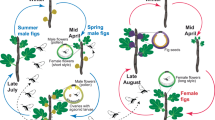Abstract
We tested the attractiveness of individual scent compounds of bat-pollinated flowers to their pollinators, small flower-visiting bats of the genus Glossophaga (Phyllostomidae). Twenty compounds belonging to four different chemical substance classes were tested, both in the laboratory and in the field. In the laboratory, the bats (Glossophaga soricina) approached odour sources spontaneously and without preceding experience. Without ever receiving any reward they preferred the scent of a sulphur-containing compound, dimethyl disulphide, to several other odour components emitted by bat-pollinated flowers, and to scentless controls. In the field, at La Selva station in the tropical lowland rain forest of Costa Rica, G. commissarisi were attracted by two sulphur-containing compounds, dimethyl disulphide and 2,4-dithiapentane, to visit artificial flowers filled with sugar water. Thus, in nectarivorous bats the sense of smell obviously plays an important role in searching for and localising food sources, and even single components of the scent bouquets of bat-pollinated flowers are attractive. The preference for sulphur-containing odours seems to be innate.
Similar content being viewed by others
Author information
Authors and Affiliations
Additional information
Accepted: 9 November 1999
Rights and permissions
About this article
Cite this article
von Helversen, O., Winkler, L. & Bestmann, H. Sulphur-containing “perfumes” attract flower-visiting bats. J Comp Physiol A 186, 143–153 (2000). https://doi.org/10.1007/s003590050014
Issue Date:
DOI: https://doi.org/10.1007/s003590050014




